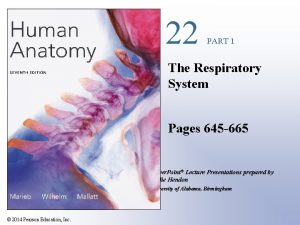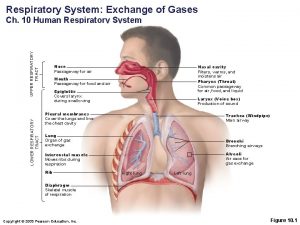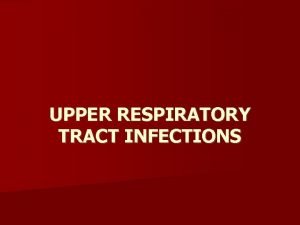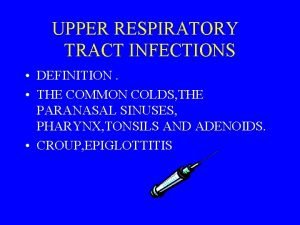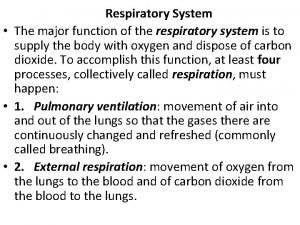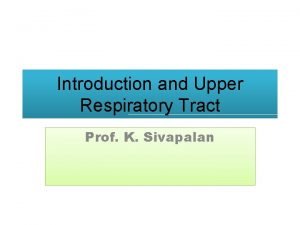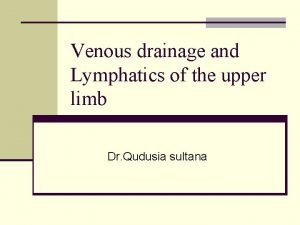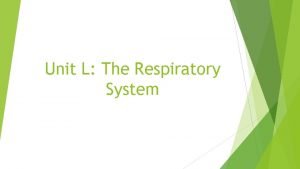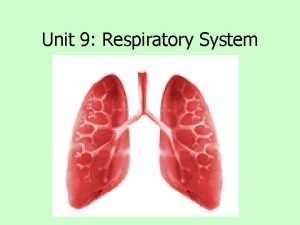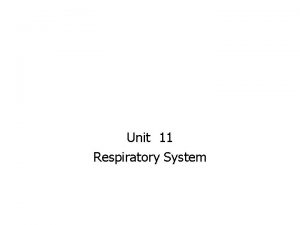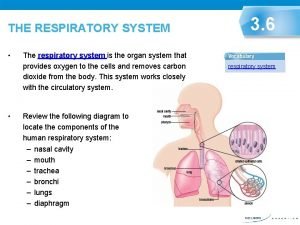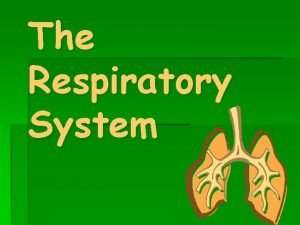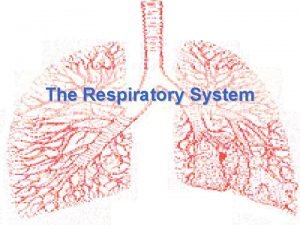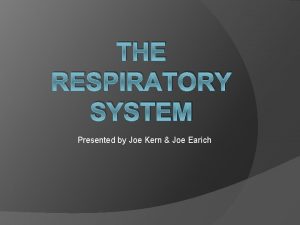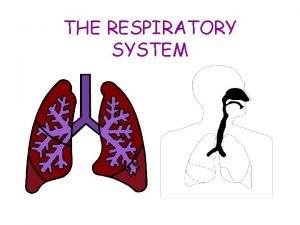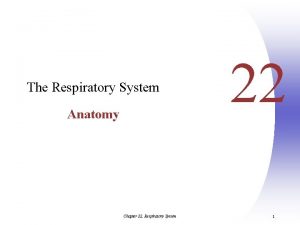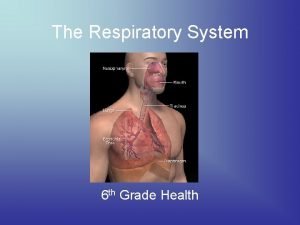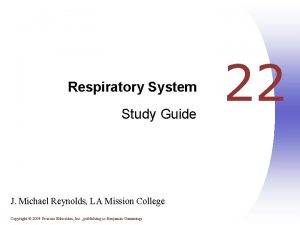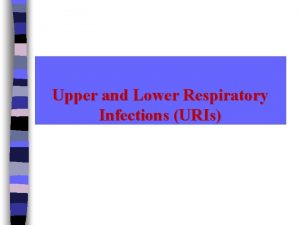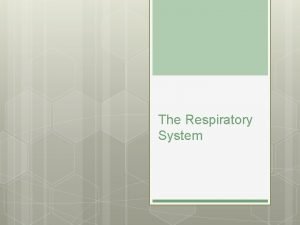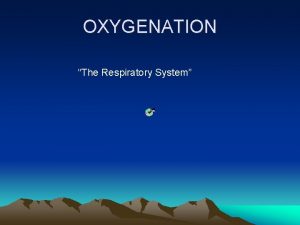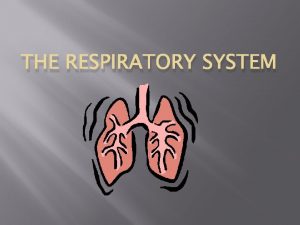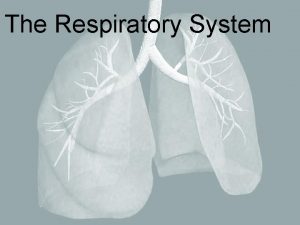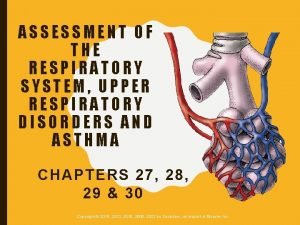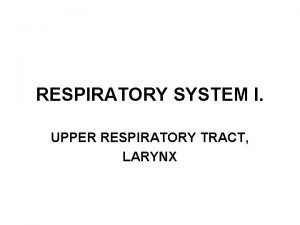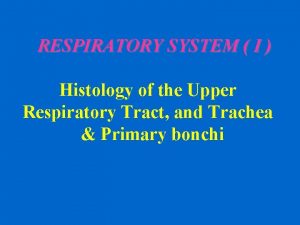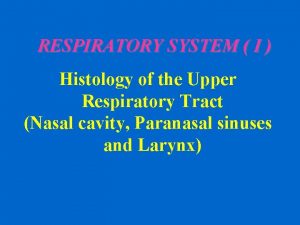Respiratory System Respiratory system structure Upper respiratory system






























- Slides: 30

Respiratory System

Respiratory system structure • Upper respiratory system – – – nose Pharynx larynx Upper part Functions: 1. Filtration 2. Warming 3. Moistering 4. Sound produce • Lower respiratory system ( from the larynx down ) – – – trachea bronchi Lungs Functions = gas exchange

Figure 23. 1

The Nose • Otorhinolaryngology (Oto= Ear, Rhino= Nose, Larynx= Throat) • Function: – Filtering Air – Odors Detection – Amplifies The Voice – Moisture Addition – Warming Air

External nose 1. Cartilage 2. Nasal bones

Nasal chamber surface Superior surface Ethmoeid Sphenoied Lateral surface 3 choncae ( superior - middle - inferior ) 3 Meatuses ( superior - middle - inferior ) Meatuses function : produce air turbulence warm and humidify incoming air trap particles Inferior surface (floor of nasal cavity ) Hard palate + Soft palate Medial surface ( septum ) the perpendicular plate of the ethmoid bone (superior) the vomer (inferior) septial cartilage (anterior)



Nostrils Coana nasal vestibule contain of nasal hairs first particle filtration system

Para nasal sinuses 1. Maxillary sinus 2. Ethmoied sinus 3. Frontal sinus 4. Sphenoid sinus

The Pharynx A chamber shared by digestive and respiratory systems Extends from internal coana to entrances to larynx and esophagus

The Nasopharynx • Superior portion of the pharynx • Contains : 1. 2. 3. pharyngeal tonsils C 1 openings to left and right auditory tubes

The Oropharynx • Middle portion of the pharynx • C 2 • Communicates with oral cavity • Contain of palatal tonsils


The Laryngopharynx • Inferior portion of the pharynx • C 3 , C 4 , C 5 , C 6 • Extends to esophagus


Larynx • Function : air way • C 3 ~ C 6 • 4 cm • Glottis & sound production

Cartilages of the Larynx • 9 cartilage : • unpaired : 1. thyroid 2. epiglotic 3. cricoid • Pair : 1. arytenoid 2. corniculate 3. cuneiform


The Glottis Two pairs of folds : 1. Vestibular folds or false vocal cords ( upper ) 2. Vocal folds or true vocal cords ( lower )

Trachea • Anterior to esophagus • From the cricoid cartilage C 6 • At T 5 it divides into right and left bronchi (CARINA ) • Tracheal rings- composed of, in the shape of a “c” • 15– 20 tracheal cartilages ( hyaline cartilage ) : – The “c” opens posterior to allow the esophagus to expand while swallowing – Protect airway – Trachealis muscle


Bronchial division 1. R & L bronchus 2. Lobar bronchus ( 3 in R --- 2 in L ) 3. Segmental bronchus 4. Bronchiole 5. Terminal Bronchiole 6. Respiratory Bronchiole 7. Alveolar duct 8. Alveolar sac


Lungs • Cone shaped organs • Lie in thoracic cavity • Separated by the mediastinum • surrounded by the pleural membrane • The pleural membrane has two layers: – Parietal pleura – Visceral pleura • Base- inferior portion • Apex- superior portion, narrow • Costal surface • Mediastinal -- contains 0 f hilus

• Right lung: – is wider – is displaced upward by liver – Has 3 lobes: separated by horizontal and oblique fissures – Superior – Middle – inferior • Left lung: – is longer – cardiac notch – Has 2 lobes: are separated by an oblique fissure 1. Superior 10 segments per lung 2. inferior Each segment contains lobules


Lobes (1)

Hillum

Radiographic Landmarks
 Physiology of lungs
Physiology of lungs Carina nasal
Carina nasal Upper and lower respiratory tract
Upper and lower respiratory tract Conductive zone vs respiratory zone
Conductive zone vs respiratory zone Classification of upper respiratory tract infection
Classification of upper respiratory tract infection Anatomy of the upper respiratory tract
Anatomy of the upper respiratory tract Ethmoditis
Ethmoditis Upper rti
Upper rti What is the major function of the respiratory system
What is the major function of the respiratory system Acute upper respiratory infection unspecified คือ
Acute upper respiratory infection unspecified คือ Digestive system respiratory system and circulatory system
Digestive system respiratory system and circulatory system How respiratory system work with circulatory system
How respiratory system work with circulatory system Circulatory system and respiratory system work together
Circulatory system and respiratory system work together Median cubital vein
Median cubital vein Brachial vein
Brachial vein Bozeman respiratory system
Bozeman respiratory system Unit 9 respiratory system
Unit 9 respiratory system Diagnostic test of respiratory system
Diagnostic test of respiratory system Respiratory system
Respiratory system Voice box respiratory system
Voice box respiratory system Respiratory system coloring page
Respiratory system coloring page Respiratory system purpose
Respiratory system purpose Conclusion for respiratory system
Conclusion for respiratory system Respiratory system jobs
Respiratory system jobs The human respiratory system chapter 7 handout
The human respiratory system chapter 7 handout Chapter 13 the respiratory system
Chapter 13 the respiratory system 22
22 Interesting facts about respiratory system
Interesting facts about respiratory system Imagine
Imagine Respiratory system diagram unlabeled
Respiratory system diagram unlabeled Respiratory system vocabulary
Respiratory system vocabulary

